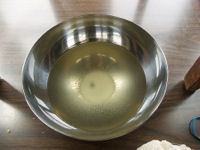Difference between revisions of "Whey"
m (Text replacement - "http://nordan.daynal.org" to "https://nordan.daynal.org") |
m (Text replacement - "http://" to "https://") |
||
| Line 3: | Line 3: | ||
==Origin== | ==Origin== | ||
[https://nordan.daynal.org/wiki/index.php?title=English#ca._1100-1500_.09THE_MIDDLE_ENGLISH_PERIOD Middle English], from [https://nordan.daynal.org/wiki/index.php?title=English#ca._600-1100.09THE_OLD_ENGLISH.2C_OR_ANGLO-SAXON_PERIOD Old English] ''hwæg''; akin to Middle Dutch ''wey'' whey | [https://nordan.daynal.org/wiki/index.php?title=English#ca._1100-1500_.09THE_MIDDLE_ENGLISH_PERIOD Middle English], from [https://nordan.daynal.org/wiki/index.php?title=English#ca._600-1100.09THE_OLD_ENGLISH.2C_OR_ANGLO-SAXON_PERIOD Old English] ''hwæg''; akin to Middle Dutch ''wey'' whey | ||
| − | *[ | + | *[https://en.wikipedia.org/wiki/12th_century before 12th Century] |
==Definition== | ==Definition== | ||
| − | *1: the [[water]]y part of milk that is separated from the coagulable part or [[curd]] especially in the [[process]] of making cheese and that is rich in [ | + | *1: the [[water]]y part of milk that is separated from the coagulable part or [[curd]] especially in the [[process]] of making cheese and that is rich in [https://en.wikipedia.org/wiki/Lactose lactose], minerals, and vitamins and contains lactalbumin and traces of fat |
==Description== | ==Description== | ||
| − | '''Whey''' or ''Milk Serum'' is the liquid remaining after milk has been [[curdled]] and strained. It is a by-product of the manufacture of [ | + | '''Whey''' or ''Milk Serum'' is the liquid remaining after milk has been [[curdled]] and strained. It is a by-product of the manufacture of [https://en.wikipedia.org/wiki/Cheese cheese] or [https://en.wikipedia.org/wiki/Casein casein] and has several commercial uses. Sweet whey is manufactured during the making of rennet types of hard cheese like cheddar or Swiss cheese. ''Acid whey'' (also known as "sour whey") is obtained during the making of acid types of cheese such as [https://en.wikipedia.org/wiki/Cottage_cheese cottage cheese]. |
| − | Because whey contains lactose, it should be avoided by those who are [ | + | Because whey contains lactose, it should be avoided by those who are [https://en.wikipedia.org/wiki/Lactose_intolerant lactose intolerant]. Dried whey, a very common food additive, contains more than 70% lactose. When used as a food additive, whey can contribute to quantities of lactose far above the level of [[tolerance]] of most lactose-intolerant individuals. |
| − | Liquid whey contains [ | + | Liquid whey contains [https://en.wikipedia.org/wiki/Lactose lactose], vitamins, protein, and minerals, along with traces of fat. In 2005, researchers at [https://en.wikipedia.org/wiki/Lund_University Lund University] in Sweden discovered that whey appears to stimulate [https://en.wikipedia.org/wiki/Insulin insulin] release, in type 2 diabetics.[5] Writing in the ''American Journal of Clinical Nutrition'', they also discovered that whey supplements can help regulate and reduce spikes in blood sugar levels among people with [https://en.wikipedia.org/wiki/Type_2_diabetes type 2 diabetes] by increasing insulin secretion.[https://en.wikipedia.org/wiki/Whey] |
==See also== | ==See also== | ||
*'''''[[Curd]]''''' | *'''''[[Curd]]''''' | ||
[[Category: Health]] | [[Category: Health]] | ||
Latest revision as of 02:42, 13 December 2020
Origin
Middle English, from Old English hwæg; akin to Middle Dutch wey whey
Definition
- 1: the watery part of milk that is separated from the coagulable part or curd especially in the process of making cheese and that is rich in lactose, minerals, and vitamins and contains lactalbumin and traces of fat
Description
Whey or Milk Serum is the liquid remaining after milk has been curdled and strained. It is a by-product of the manufacture of cheese or casein and has several commercial uses. Sweet whey is manufactured during the making of rennet types of hard cheese like cheddar or Swiss cheese. Acid whey (also known as "sour whey") is obtained during the making of acid types of cheese such as cottage cheese.
Because whey contains lactose, it should be avoided by those who are lactose intolerant. Dried whey, a very common food additive, contains more than 70% lactose. When used as a food additive, whey can contribute to quantities of lactose far above the level of tolerance of most lactose-intolerant individuals.
Liquid whey contains lactose, vitamins, protein, and minerals, along with traces of fat. In 2005, researchers at Lund University in Sweden discovered that whey appears to stimulate insulin release, in type 2 diabetics.[5] Writing in the American Journal of Clinical Nutrition, they also discovered that whey supplements can help regulate and reduce spikes in blood sugar levels among people with type 2 diabetes by increasing insulin secretion.[1]
